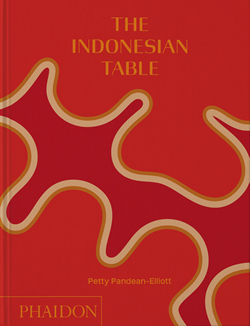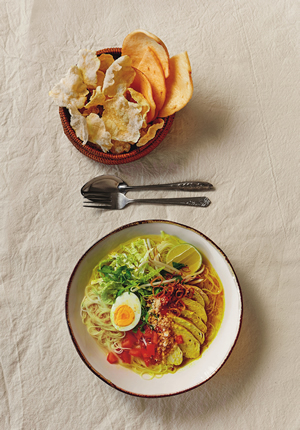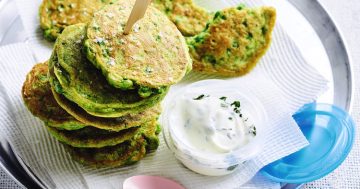By Christine Salins.
 Indonesia is known for its skewered satays, beef rendang and sambal, but there is much more to the Indonesian table, as Petty Pandean-Elliott demonstrates in The Indonesian Table (Phaidon Books, $49.95).
Indonesia is known for its skewered satays, beef rendang and sambal, but there is much more to the Indonesian table, as Petty Pandean-Elliott demonstrates in The Indonesian Table (Phaidon Books, $49.95).
“Historically, Indonesian cuisine has been influenced by cultures from around the world, and vice versa. At one point, Indonesia was the centre of nutmeg and clove trade and remains a top producer today.
“The marriage of Arabic, Indian, European (Dutch, Portuguese and Spanish), Chinese and Peranakan influences with our indigenous ingredients has culminated in a fantastically original culinary tapestry.”
Pandean-Elliott, a chef and author of several bestselling Indonesian cookbooks, says Indonesian cooking is all about layering flavours to create good food for the body and soul.
When she describes Indonesian food, she is also telling the story of her life, as her own culinary and cultural experience runs through the pages of the book. She describes enjoying an idyllic childhood in Manado, “a distant north-east corner of Indonesia … a centre of trade in vanilla, cloves, nutmeg, coconut products and seafood.”
When she was 13, her family relocated to Jakarta and she experienced a whole array of new dishes, from street food to hawker markets to traditional warung eateries. With Dutch and East-Asian ancestry, Pandean-Elliott began to reconstruct her culinary past, her travels taking her around Java, Bali, Lombok and Sumatra, as well as on trips abroad. She relocated to the UK in 2018.
All this experience has gone into The Indonesian Table, which is a comprehensive guide to making a vast range of dishes. The dish here from Java is her ultimate comfort food, bursting with flavours and textures. It is gluten-free and dairy-free, and if you add toppings like lime juice or sambal, it is even more flavoursome. In some regions, coconut milk is added.
 CHICKEN SOTO WITH TURMERIC AND LEMONGRASS
CHICKEN SOTO WITH TURMERIC AND LEMONGRASS
Serves 8
For the soto:
1 tablespoon sunflower oil
1 quantity yellow spice paste
1 (1.2-kg) chicken, cut into 8 pieces and skin removed
4 makrut lime leaves, torn
2 stalks lemongrass, crushed
Salt, to taste
200 g dried rice vermicelli or glass noodles
For the toppings:
4 eggs (optional)
2 large tomatoes, seeded and cut into ½-cm cubes
150 g (1½ cups) shredded cabbage
3 tablespoons bean sprouts
3 tablespoons chopped
Chinese celery or celery leaves
4 tablespoons koya
8 slices lime, halved
To serve:
8 lime slices
1 quantity boiled sambal
Melinjo crackers or prawn crackers
To make the soto, heat the oil in a large saucepan over medium heat. Add the spice paste and sauté for 3 to 4 minutes. Add the chicken and cook for 5 minutes, stirring occasionally. Add the lime leaves, lemongrass and 1.5 litres (6¼ cups) of water. Season with salt. Bring to a boil, then cover and reduce the heat to medium-low. Simmer for 45 minutes, skimming any scum from the surface with a ladle.
Meanwhile, prepare the dried noodles according to the package directions. Drain, then transfer to a bowl of cold water. Drain again, then set aside.
Put the eggs, if using, into a small saucepan of water. Bring to a boil and boil for 10 minutes. Drain, then transfer to a bowl of cold water to stop the cooking process. When cool enough to handle, peel the eggs and cut them in half.
Transfer the chicken to a chopping (cutting) board and let cool. When cool enough to handle, pull the meat away from the bone and cut into slices. Set aside.
Put the noodles into bowls. Add the tomatoes, cabbage, bean sprouts and chicken. Ladle 2 to 3 spoons of hot broth into the bowls. Sprinkle with Chinese celery and koya. Add half an egg and a lime slice to each bowl. Serve with sambal and melinjo crackers on the side.
Variations:
- Chicken Soto Banjar (Soto Banjar)
Replace the yellow spice paste with white spice paste. When frying the paste, add 3 green cardamom pods, 2 star anise, 1 (5-cm) stick of cinnamon and 1 teaspoon each of ground nutmeg and clove. Omit the koya.
- Jakartan Soto with Noodles (Soto Mie Jakarta)
Replace the yellow spice paste with white spice paste. Replace the chicken with beef topside (top round) or cheeks and cook for 1½ hours, or until the beef is tender. Replace the rice noodles with egg noodles. Omit the koya and egg. Serve with boiled sambal and spring rolls as well.
Recipe and image from The Indonesian Table by Petty Pandean-Elliott, photo by Yuki Sugiura. Published by Phaidon, $49.95.




